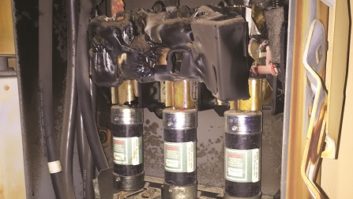Bob Meister is a contract engineer and active amateur radio operator in the New Haven, Conn., area. He notes that most broadcast facilities have uninterruptible power supplies powering critical equipment. Bob even has several at his own house for the network and computers, mainly to keep things running when the power fails until his whole-house generator takes over the load.
The APC Smart-UPS series is one of the most popular. These standby units turn their inverter on when the power fails, and use relays to switch the load to the inverter. This provides a nice clean sinusoidal waveform. They also do a self-test every two weeks by default; it acts as if the incoming power failed, forcing a switchover to the inverter. If the battery voltage drops too far, a front-panel LED will light, indicating that it’s time to replace the batteries.
An operating quirk is that they will not turn on unless there’s a good battery present and connected. Many of these units use multiple batteries wired in series, so all of the batteries must be capable of providing close to 12 volts and several amps of current to be considered good.
[Check Out More of Workbench Here]
If a battery develops a high internal resistance, it will measure the right voltage but be incapable of providing any current to the load. When the UPS does its self-test, it starts its inverter, which puts a load on the batteries. The battery voltage goes to zero; the UPS inverter can’t run; the UPS shuts off; and it can’t supply power to the loads.
Because there’s now no voltage across the batteries, the unit will not turn on either. There’s no bypass mode in these units. Now you’re in a bad situation: All the loads have just shut off with no warning, and you can’t power them up unless you move all the electrical plugs to a regular outlet or install new functioning batteries into the UPS. If this happens on Friday night when the station is unattended, it could be a very long weekend off the air.
Bob recently experienced this situation at home with an APC SU1000 UPS with two-year-old batteries. There was no indication that the batteries needed to be replaced; the UPS and everything plugged into it just shut off at the time the self-test was due to occur. It had successfully passed the self-test two weeks earlier. Upon investigation, one battery measured 13.6 VDC with a high-impedance digital multi-meter, but the voltage went to zero with the slightest current draw (under 0.1 amp). No battery voltage, no UPS operation. “It’s dead, Jim!”
Another “no power” situation can happen when you’re running on a generator and the UPS is unhappy with the condition (voltage or frequency) of the incoming generator power. Some units, even online models, will refuse to pass sub-standard power to the load and will run exclusively on their batteries until they fully discharge.
At this point, the UPS has to make a choice: Shut off or go into bypass mode. Most just shut off. A better choice would be to go into bypass mode and at least let the loads receive power from the generator, which is probably much more desirable than no power at all.
An engineer at a local radio station was discussing these problems with Bob and came up with a circuit to prevent these sorts of UPS outages from shutting off critical equipment and taking the station off the air. Bob did some research and found an appropriate relay.

See the schematic in Fig. 1. This relay uses a 30A DPDT relay (Magnecraft 300XBXC1-120A) to route utility or UPS power to the loads. When the UPS is providing output voltage, it energizes the relay and the loads receive power from the UPS. If the UPS dies or is shut off, the relay drops out and the loads receive power from the utility.
Fig. 2 shows the finished product. Neon indicating lights across both power sources let you know at a glance what power source is present. Everything was installed inside a 4-3/4 inch square deep electrical box with #12-3 wire and 15A plugs (these probably should be 20A plugs) supplying input power and two 20A duplex outlets to feed the loads. The cord that plugs into the UPS is about two feet long; the cord that plugs into the utility outlet is about 6 feet long. One of these assemblies is required for each UPS.

The relay costs under $25 from Mouser; the rest of the parts can be purchased at a home improvement store.
Most standby UPSs allow their batteries to be swapped without turning the UPS off. However, there’s always the possibility that the on/off button could get pushed during that procedure, or the UPS could decide to perform its self-test when the batteries are out, or one of the new batteries could be defective. This circuit allows you to shut the UPS off if you want to minimize the risk of losing power to everything plugged into it. The loads will just get powered from the utility, which hopefully won’t fail during the brief changeover. If you’re worried about that happening, fire up the generator and switch over to it when you work on your UPS.
Most relays are rated by their Normally Open (NO) contact current; the Normally Closed (NC) contacts are often only capable of 20 percent of the NO rating, due to the spring tension available. This application requires equal current capability and continuous operation. Bob contacted Magnecraft and asked about the ratings on the above relay.
“The 300 series is rated at 30A at 300VAC for both NO and NC,” the company replied. “That being said, the electrical operations are de-rated on the NC contact (NO=100k ops/hr; NC=6k ops/hr) at that rating. Unfortunately, the 300 series is not rated at constant duty. Over time, corrosion will develop on the contacts. The act of switching will create a small arc; this arc will actually clean the contacts.”
It said many people do use the relay in these types of applications. “However, we recommend occasionally cycling the relay to clear any corrosion and prolong the life of the relay.”
***
BBN Network Staff Engineer Steve Tuzeneu sent a link for stations to consider when needing to do free remotes: http://cleanfeed.net/.
Cleanfeed uses the Opus codec and can run either mono or stereo audio.
Contribute to Workbench. You’ll help fellow engineers and qualify for SBE recertification credit. Send Workbench tips to johnpbisset@gmail.com. Fax to (603) 472-4944.
Author John Bisset has spent 46 years in the broadcasting industry and is still learning. He handles West Coast sales for the Telos Alliance. He is SBE certified and is a past recipient of the SBE’s Educator of the Year Award.







